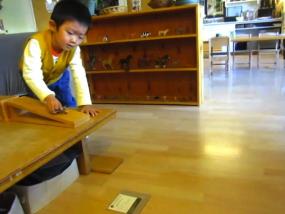Change your aim or move the target

In this video, Jon makes an interesting addition to a familiar scene. He enjoys rolling toy cars, airplanes and a truck down a ramp that is placed at the edge of the tabletop. On the floor below, Jon uses a carpet tile as a landing pad. Notice how he often says, “Uh-oh,” when a toy misses the landing pad on the floor. We join the action as Jon places a green car at the top of the ramp, releases it, and pauses momentarily to observe where the car lands. The car comes to rest on the bare floor rather than the landing pad. Jon responds, “Uh-oh” (00:05-00:11). He slides the carpet tile to the spot where the car landed. Cleverly, Jon uses the previous fall to infer where the next fall will be. He uses a sort of "backward chaining," a problem solving strategy, using something that happened at Time 2 as information for what to do at Time1; he reasons backward from the desired outcome. We notice that Jon moves the carpet tile to the spot where the car rolled rather than where the car first makes contact with the floor. Do you think he included the roll in his calculation when he moved the carpet so far from the end of the table? Amazingly, in the next round (00:23), the car comes to rest directly on the landing pad. Jon responds to this success by changing the conditions of his game. He slides the landing pad to a spot where the car has not yet landed (00:37). He also changes the starting point of the car by placing it on the level block, rather than at the top of the inclined ramp (00:44). Jon likely does not want his game to end, so he invents ways to increase the level of challenge and possibly delay success. We saw another example where children complicated a game to make it more fun in “Why Children Make Play Challenging.” The child knows the car will not roll on its own when placed on a level surface, so he gives it a push. Perhaps Jon hopes the car will gather more speed, but instead, the level block adds more distance. The force of his push causes the car to fall (00:45). Jon says, “Uh-oh,” as he enthusiastically jumps down to retrieve the car. He revises his strategy by guiding the car across the level surface before releasing at the top of the incline (00:50). Notice that Jon closely observes the car as it passes the landing pad and comes to rest on the floor. Again, he responds by saying, “Uh-oh” (00:53). A pattern emerges in which Jon enjoys creating scenarios where the expression, “Uh-oh,” is an appropriate response. He may have recently learned this expression and is experimenting with its usage during play. In the next round, Jon selects a toy airplane. The plane travels only halfway down the ramp (01:03), and Jon says, “Uh-oh.” He gives the plane another push, and it slides down the ramp and falls directly to the floor (not the landing pad). Again Jon responds by saying, “Uh-oh.” Saying, “Uh-oh,” could be a way to make this small failure less upsetting, almost as if it is fun when things don’t quite work out. If so, Jon's use of the expression, "Uh-oh," could also be a mark of a resilient child who has developed strategies for dealing with frustration (for additional examples see the Learning Moments CD "Children Dealing with Frustrations”). On the next pass, Jon decides to fly his airplane over the level block and lower it to the inclined block (01:26) before watching it fall to the floor. He wants to "stay in character" (it's a plane) when the plane will not roll on its own over the level block. And at the same time, this pretense of flying solves the real problem that, unlike the car, the plane will not roll. Thus is the power of play, to solve a physical problem using an action that is appropriate for pretense. We know that during early language development young children tend to over apply newly learned words. But why might the expression, “Uh-oh,” hold particular interest for the young child? Jon may be attracted to its melodic singsong sound. Many of the words a young child is learning are labels for people, places and things. However, the expression, “Uh-oh,” is an onomatopoeic word that conveys emotion and often surprise. The expression “Uh-oh” represents a whole event in that it is conventionally used when one realizes something unintended or mistaken has just occurred. In his game, Jon gives the perceived “mistake” or unintended outcome better definition by deciding to include the landing pad. The landing pad provides a clear target that might be missed. We often notice how children develop goal markers, a strategy for making success more explicit, which is particularly important when playing a game with others. As Jon continues playing, notice the adjustments he makes and listen for the instances when he expressively says, “Uh-oh!” Length of video: 2 minutes 39 seconds Keywords: Threes, Child-Object, Toy cars, Ramps, Inclines, Language, Frustration
